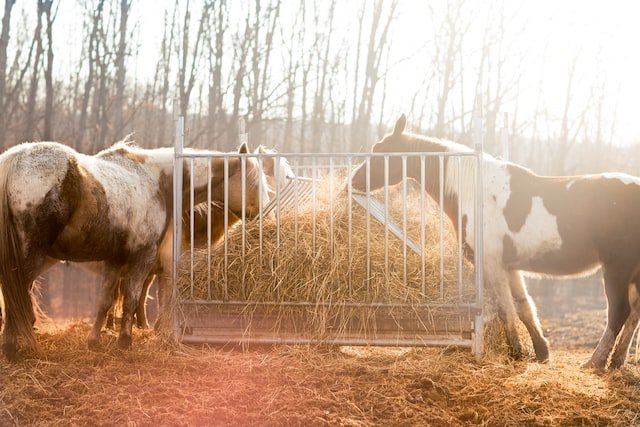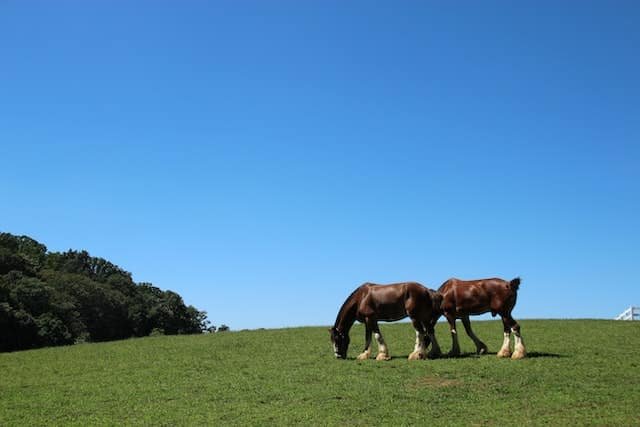How do horses digest cellulose? Answer: Through one of nature’s magical processes called Hindgut Fermentation.
Bacteria in a horse’s colon break down the cellulose to release fatty acids which can then be absorbed by the horse and harvested for nutrients. How did the horse (and other equids) end up being able to do this? It’s a long story that spans 60 million years.
And here’s the shorter version…
What is Cellulose?
Cellulose is a complex carbohydrate and is the main component of plant cell walls. It gives plants their structure. Cellulose is insoluble and indigestible in humans. It is the fiber that passes through our digestive system and gives bulk or roughage to our stools and keeps us regular.
Since horses are herbivores, their diet consists mostly of plants. This means that a large part of their diet is cellulose. And the horse has a way to extract nutrients from cellulose, which is what we will discuss in this article.
Evolution & Cellulose: Changing Environment, Changing Diet
Before we can understand how horses digest cellulose, we need to discuss why they need to digest cellulose. For that, we need to understand how, over the last 60 million years, horses evolved to adapt to their environment and survive.
The oldest known ancestor of the horse was the Eohippus which lived in forests and ate fruit, leaves, and nuts. But as climate change over millions of years replaced the forests with grasslands, the Eohippus too evolved through multiple iterations to form the modern horse – the Equus Caballus, who was now well-suited to live on grass and extract most of its nutritional needs from grass.
And this required extracting all it could from cellulose as well.
Grass, Hay & Nutritional Needs
Horses eat grass and hay. Often, in the summer horses will eat grass while grazing. In the winter, they will eat hay. Why do they eat grass and hay? Because they are made for it.
Evolution has given them the jaws, teeth and digestive system needed to eat grass, hay and vegetation, and extract as much nutrition from it as anyone possibly can.
Like humans, horses need a balanced diet too. And as with us, a balanced diet for them consists of proteins, carbs, fat, water and minerals.

Cellulose plays a role in this balanced diet. It provides the horse with fiber, which is essential for good digestive health. Fiber moving through the intestines helps to keep them clean and healthy and also keeps the horse feeling full. But what is most interesting is that horses use a process called hindgut fermentation to break down cellulose and extract nutrients from it.
So, hindgut fermentation fermentation is the secret that makes it possible for a horse to digest cellulose and extract protein from grass.
How Does a Horse Digest Cellulose?
As we saw earlier in the article, cellulose is a carbohydrate and a fibrous substance that gives structure to a plant. It is a primary component of plant walls but is not digestible by most mammals including humans.
The enzymes in our digestive tracts are responsible for breaking down the carbohydrates we eat into glucose which is then absorbed by the body and used for energy. But cellulose is different. Our digestive enzymes cannot break down cellulose.
This is where the horse and other members of the equid family (rhinoceroses, tapirs, etc) are different. Equids utilize a process called hindgut fermentation to break down the cellulose.
In mammals, the digestive tract includes the stomach followed by the small intestine, the cecum, the large colon, and then the small colon. Enzymatic digestion occurs in the small intestine where the enzymes break down our food to extract nutrients. But, cellulose passes through untouched by enzymatic digestion and reaches the cecum and then the colon.
And it is in the horse’s colon that nature’s magic occurs.
The horse’ colon (and even its cecum) carries bacteria that are able to break down the cellulose into fatty acids. The horse absorbs these fatty acids and doing so, extracts additional nutrients from cellulose.
To make this easier, evolution has given horses, colons that are larger than those of mammals that are unable to break down cellulose.
So that is how a horse is able to digest cellulose. And this is just one of many amazing adaptation facts about horses.
If you want to geek out on this topic, I’ve included some excellent references below.
The Bottom Line
So how do horses digest cellulose? Horses digest cellulose through a process called hindgut fermentation, where bacteria in the colon break down the cellulose and allow the horse to extract nutrients from it.
References
https://www.vetfolio.com/learn/article/digestion-in-the-horse



